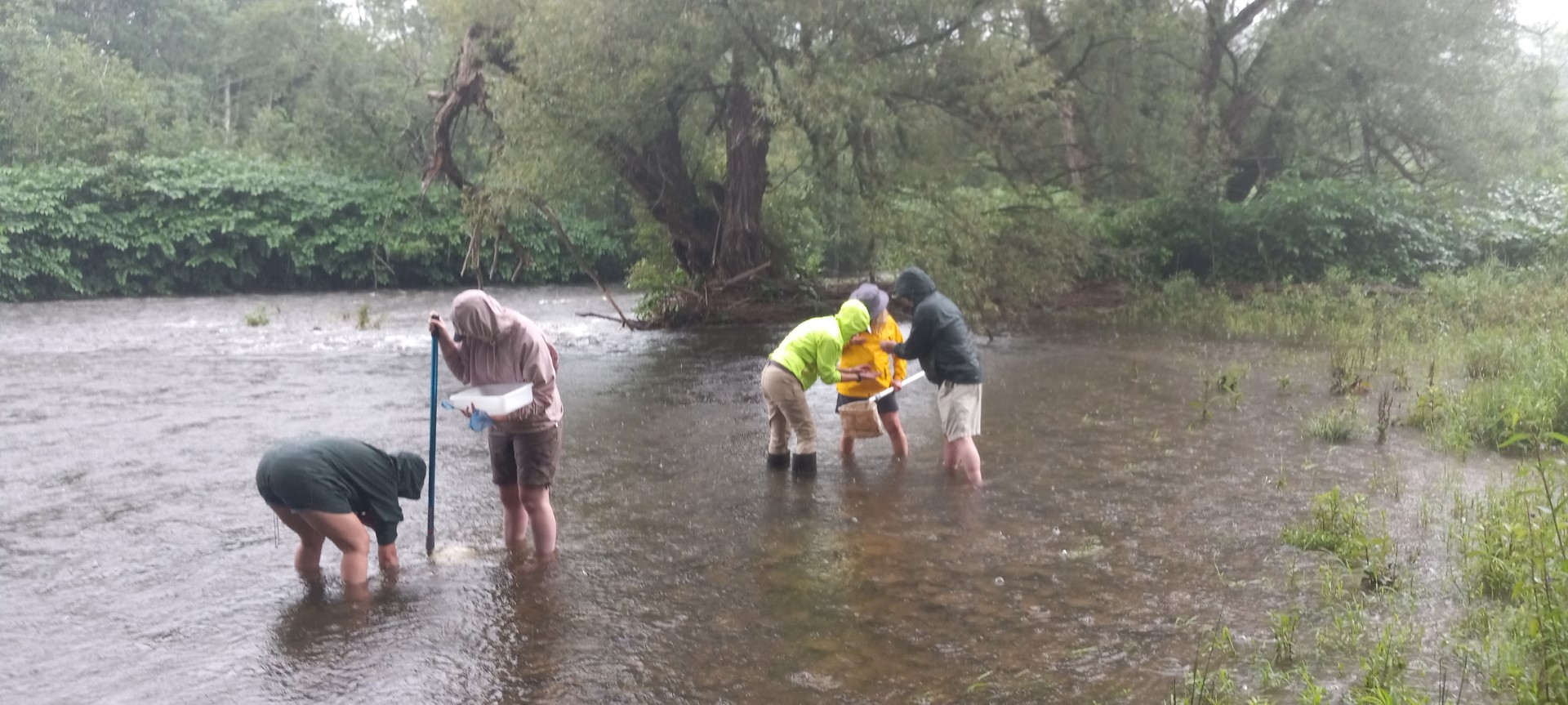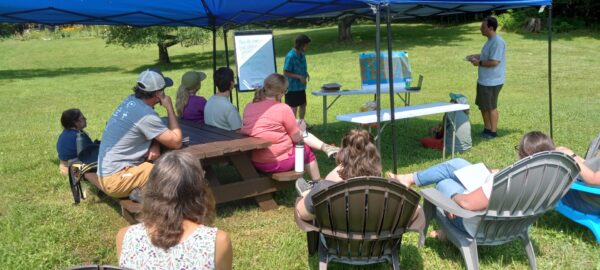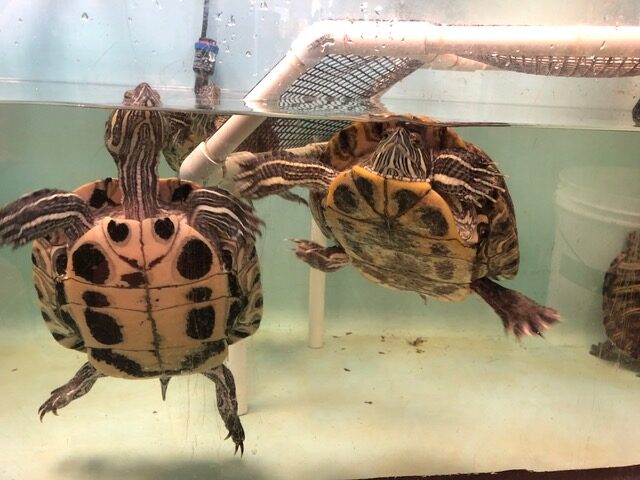It was early morning on a patio just outside the Conowingo Dam, and Mike Martinek was looking at hundreds of juvenile eels that had been suctioned from the Susquehanna River into a giant freshwater pool. Martinek, a fisheries biologist for an environmental consulting firm, and a couple of colleagues were planning to truck the eels a couple of hours north into Pennsylvania, past Harrisburg, and dump them near spawning grounds upriver.
“We’re the eel Uber,” Martinek laughed.
Many of these eels, who are generally 2 to 4 years old, were hatched in the Sargasso Sea, in the Atlantic, and have been propelled by tides to the Conowingo Dam, almost randomly.
“They could be from Georgia or Norway,” Martinek said. “It’s a mixing bowl. You just don’t know.”
Some 200,000 eels will pass through the dam this year, many using a chute that simulates a creek.
“We’re the only eel collection facility on the Susquehanna, and one of the biggest on the East Coast,” said Andrea Danucalov, manager of regulation and licensing at the dam — in short, the environmental compliance officer.
That this daily activity is the first thing that Constellation Energy officials showed a couple of reporters who had come recently for a tour of the mighty Conowingo Dam may not be a coincidence.
Throughout the three-hour visit, company executives repeated over and over how important environmental stewardship is to Constellation, especially at the dam, a pressure point for myriad marine and animal species. In fact, the tour guides said, environmental considerations go into every decision the company makes about the operation of the dam. And Conowingo, they say boldly, is at the cutting edge of the fight to address climate change in the state: it’s far and away the largest producer of renewable energy in Maryland.
Up and down the corporate food chain, company officials at Constellation and its predecessor entities have made the same assertions for years. It’s almost as if the main purpose of the dam — generating hydropower at Conowingo for the past 95 years — is an afterthought. But maybe that’s to be expected.
In the broad debate over the health of the Chesapeake Bay, Conowingo Dam is in many ways the 800-pound gorilla in the conversation — or to put it more precisely, the 572-megawatt gorilla, the maximum level of electricity the dam can generate on an annual basis, which is enough to power about 165,000 homes. That prevents 867,000 metric tons of carbon emissions from going into the atmosphere every year, the company estimates — the equivalent of taking 186,000 cars off the road.
But recently, Constellation’s environmental performance is back in the news, after the state of Maryland, responding to a court order, reopened the process for issuing a clean water operating permit for the dam, which Constellation needs to be granted a new 50-year operating license from the federal government. After taking public comments over the past several weeks, mainly from the parties involved in prior lawsuits over the dam, but also, more informally, from everyday folks, the Maryland Department of the Environment is poised to issue a decision on the permit fairly soon.
The environmental group that monitors the health of the Susquehanna River in the vicinity of the dam believes the permitting process needed to be reopened, arguing that the administration of former Gov. Larry Hogan (R) cut corners when it reached a settlement with Constellation in 2019 — and that Constellation has to do a better job of protecting the waters that create great profits for the company.
“They have to stop being in denial,” said Ted Evgeniadis, executive director of the Lower Susquehanna Riverkeeper Association. “That’s the first step — admitting you have a problem.”
Constellation executives, however, believe that the settlement that led to the Hogan administration waiving water permits, which in turn prompted the Federal Energy Regulatory Commission to issue a 50-year license, represents a high point of cooperation between the company, government officials, environmentalists and other stakeholders.
“We know what the solutions are,” said Kathleen Barrón, executive vice president and chief of strategy for Constellation. She urged the state to preserve “the intense work” stakeholders did leading up to the 2019 agreement with the state.
Constellation executives also note that the Lower Susquehanna Riverkeeper Association is the only regional environmental group that has vocally called the company’s supervision of the dam into question (leaders of other green groups maintain they largely defer to the riverkeeper organization on matters of the Conowingo Dam).
And Constellation officials are quick to tick off the environmental and financial benefits to the state, to the Chesapeake Bay, and to the Bay watershed. Constellation, they say, does more to protect the Susquehanna, the Bay and the watershed than any other private entity. Extending the company’s license another 50 years will generate more than $700 million in financial and environmental benefits to the state, the company maintains.
When the company isn’t shepherding eels through the dam, it’s operating a fish lift that gets tens of thousands of American chad, river herring and other species through the works — and also stops many invasive species from getting into the Bay. The company also has a bald eagle management plan in place, as the area just south of the dam is one of best spots to see migrating and nesting eagles anywhere in the U.S.
Evgeniadis, at the Riverkeeper Association, predicts that the state’s upcoming decision on the water quality permit will produce one of three results: Incentives for environmentalists and Constellation to return to the bargaining table; a decision that environmentalists like and prompts the company to sue; or a decision that Constellation likes and prompts the riverkeeper association to sue.
But this battle over the water quality permit is just the latest environmental fight involving the Conowingo Dam. Though it’s not universal, there’s a general fear and loathing over the dam in the Upper Bay region, not just among environmentalists, but also watermen, local elected officials, and business and civic leaders.
Every year, the Clean Chesapeake Coalition, a loose confederation of leaders in the Upper Bay area, holds a standing room-only meeting at the Maryland Association of Counties summer conference. Every year, the participants complain about environmental regulations they consider onerous and about pollution that comes from upriver, mainly from agricultural sources, in Pennsylvania — narratives that seem almost contradictory. And they complain about the Conowingo Dam.
“When you try to find out about the integrity of the dam, the safety of the dam, you can’t really tell what’s going on,” Charles “Chip” MacLeod, general counsel for the coalition, said at the most recent meeting.
An architectural wonder
The Conowingo Dam itself is an architectural and engineering wonder, and the craftsmanship and handiwork of the industrial era are very much in evidence everywhere, even as modern energy generation becomes more automated. Constellation has been careful to keep all of the 1920s architectural infrastructure and flourishes intact, and a visit to the dam, notwithstanding some of the technology used to run it these days, seems very much like a trip to a bygone era.
To start construction of the dam, in the 1920s, a vast concrete wall had to be sunk 40 feet below the riverbed. The dam has 11 gates with massive turbines that impact the river flow and the amount of energy the dam is generating. Only twice have all 11 gates been open — once during a storm in 1934, and again during Hurricane Agnes, considered the most damaging in the region’s history, in 1972.
Inevitably, a tour of the Conowingo Dam takes a visitor to the reservoir on the north side of the hulking structure, across U.S. Route 1, where tons of debris collects and is prevented by the dam from flowing downriver and into the Chesapeake Bay. This is undoubtedly the most controversial aspect of the Conowingo and the flashpoint for the years-long animus between various stakeholders and the company.
On a recent morning, the visible debris mainly consisted of logs, tree limbs and other natural detritus, but also included tires, balls, large plastic bins, diapers, planters, and other refuse. On this windy but pleasant day, the accumulation seemed fairly benign.
But there is a constant fear among communities downriver that violent storms or even higher than average flooding could send much of the waste tumbling down the dam, which was built at a place in the Susquehanna where there is a 200-foot elevation drop, and into the river and the Bay beyond.
“I’m not trying to be alarmist, but a catastrophic failure — there would be all kinds of impacts, including environmental impacts,” MacLeod said.
Here, the more conservative members of the Clean Chesapeake Coalition and the environmentalists who run the riverkeeper organization are basically in accord. Evgeniadis accuses Constellation of “turning a blind eye to the massive problem that’s behind them” at the dam.
The riverkeeper says the reservoir abutting the dam is supposed to be at least 100 feet deep, but now with all the silt and other debris that has accumulated through the decades, they believe it’s more like 12 or 15 feet deep in parts, increasing the threat of dangerous materials spilling over the dam and into the river below. Constellation representatives said the average depth ranges from about 15 feet to about 40 feet, with the deepest point, about 80 feet, immediately upstream of the powerhouse.
Some neighbors of the dam, including many of the leaders of the Clean Chesapeake Coalition, would like to see the reservoir dredged. They note that the silt that’s dragged from the river’s bottom could be used to reinforce coastal areas and other and waterfront communities in the region.
But Constellation executives believe the idea is impractical and expensive, and here they seem like they are in accord with the riverkeeper organization.
“It’s inevitable that the reservoir behind that dam would fill up [with silt and debris] again,” Evgeniadis said.
The debris currently bobbing in the water nestled against the dam will be collected by boom, placed on a barge, to a landfill and recycling area a few miles up the river, in Pennsylvania. Constellation estimates that it removes 600 tons of garbage and debris from the dam area every year and that its debris removal efforts, combined with ongoing research into improving ways to remove refuse from the area, produce benefits valued at $41 million.
‘A public resource for private profit’
The Conowingo Dam does not operate in a vacuum. While it’s the biggest dam on the Susquehanna — indeed it’s the biggest power-generating dam on the entire East Coast — there are three other dams upriver in Pennsylvania, owned by different companies, and what happens at those facilities can impact Conowingo. In a fact sheet on Conowingo, Constellation maintains that the dam operators upriver “have not committed to the same debris removal activities” as Constellation.
What’s more, the dam is susceptible to extreme weather, and other swift changes in natural conditions.
“I never thought when I took this job I’d become a weatherman,” said Amir Hassad, an engineer who is the dam manager.
In its efforts to be a good corporate citizen, Constellation maintains a large riverfront promenade at the base of the dam that’s popular with fishermen, bird watchers, picnickers and nature lovers, and is a gateway to hiking trails maintained by various public, private and nonprofit entities. Just up the road from the dam, the company offers a public pool, a visitors center and a history museum.
Evgeniadis does not discount the company’s good works, but notes that Constellation is “taking a public resource for private profit.”
“They’re not going to be able to operate in the same way they’ve been operating it for the last 100 years,” he said. “Things are going to have to change.”
So the battle lines are drawn, pending a decision from the Maryland Department of the Environment. Jay Apperson, an agency spokesperson, said last week that MDE did not have a timetable for issuing the new water permit.
Environmentalists and other neighbors warn that the dam presents a huge potential threat to communities, public health, the environment, marine life and wildlife. Constellation executives insist that without their environmental stewardship and vigilance, conditions throughout the region could be much worse.
After a visit to the dam and its environs, it’s easy enough to conclude that both assertions can be true at the same time.
By Josh Kurtz









